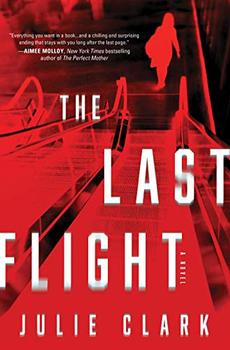Summary | Excerpt | Reading Guide | Discuss | Reviews | Beyond the Book | Read-Alikes | Genres & Themes | Author Bio

Critics' Opinion:
Readers' Opinion:
First Published:
Jun 2020, 320 pages
Paperback:
May 2021, 288 pages
 Book Reviewed by:
Book Reviewed by:
Kim Kovacs
Buy This Book
This article relates to The Last Flight
 The action in Julie Clark's novel The Last Flight begins as two women decide to switch identities at an airport and each board the other's flight. One of the two airplanes crashes into the ocean before reaching its destination.
The action in Julie Clark's novel The Last Flight begins as two women decide to switch identities at an airport and each board the other's flight. One of the two airplanes crashes into the ocean before reaching its destination.
In 2019, over 4.5 billion trips were scheduled on commercial airplanes worldwide, and 1.1 billion of these were on airlines serving the United States either domestically or internationally. It's big business, too; as of 2019, statistics reported by the FAA stated that aviation contributed more than 5 percent of the U.S. gross domestic product, and approximately 10.6 million jobs in the country were being generated by the industry.
Following the first successful airplane flight made by Orville and Wilbur Wright in 1903, the first commercial airline was a short-lived venture that took off (literally) on January 1, 1914, when two businessmen in Florida decided to try to provide routine flights between Tampa and St. Petersburg. The two cities are situated on either side of a bay, and at the time options for transport between them were limited and time-consuming. A steamship took two hours for the trip, rail took four to 12 hours, and drivers could make the journey in about 20 hours; a flight, however, would only take around 20 minutes. The airline made two flights a day, six days a week, and cost passengers $5 per trip (the equivalent of about $100 today). It only operated for four months, but carried over 1,200 passengers during that time; its last flight was on April 27, when winter residents in the area had begun to leave, decreasing the demand for the airline. Nevertheless, the experiment set the stage for later entrepreneurs.
Regular passenger flights began in the 1950s, spurred by aeronautics innovations conceived during World War II. There was no such thing as airport security, however, until United Airlines flight 629 from Denver, Colorado to Portland, Oregon exploded just after takeoff on November 1, 1955, killing all 44 individuals aboard. Investigators collected the wreckage and reassembled as much of the downed aircraft as they could. They were able to determine that the cause was a dynamite bomb placed in a piece of luggage. Suspicion quickly fell on Jack Gilbert Graham, the son of one of the passengers, who had previously been implicated in various illegal schemes and who had purchased a life-insurance policy at an airport vending machine just before his mother's flight departed. Graham admitted his crime, and showed no remorse for the collateral damage his actions caused (or for the murder of his mother, apparently). At the time, there were limited legal penalties for what he had done, so he was prosecuted only on the killing of his mother. He was found guilty and executed in the Colorado State Penitentiary gas chamber on January 11, 1957.
Perhaps surprisingly, security still wasn't extensive after that incident. The government did begin to place armed guards on planes in 1961. However, it took a rash of plane hijackings in the late 1960s and early 1970s for widespread restrictions to be put in place; between 1968 and 1972, there were more than 130 hijacking attempts – an average of one every other week. In 1969, increased FAA (Federal Aviation Administration) security measures started with training ticket agents to profile their customers and call for additional screening of anyone who looked suspicious. Needless to say, it wasn't a terribly effective method of deterrence. Undercover Customs Air Security Officers (aka "sky marshals") were employed starting in 1970 and an Explosives Detection Canine Team Program was added to airports in 1972. In 1973, the FAA began requiring all commercial airlines to use X-ray machines to scan luggage as well as metal detectors to screen passengers for weapons and explosive devices.
Security at airports was tightened even further in the wake of the 9/11 terrorist attack in 2001. Restrictions on what items could be taken onto a plane went into effect (as anyone who's flown in the years since can attest), and more thorough screening measures have been put in place. Thanks to Richard Reid (aka the Shoe Bomber), many flyers also have to remove their shoes to have them scanned separately at the security checkpoint. Reid, a British citizen, tried to blow up a flight from France to Miami using plastic explosives concealed in his shoes on December 22, 2001. It's possible that the only reason his plan didn't work was that the fuse was damp from the sweat from his feet. He was sentenced to three life terms plus 110 years, with no option for parole.
Regardless of these incidents (or maybe in part because of them) airplane travel remains one of the safest modes of transportation one can take. According to the National Safety Council, the lifetime odds of dying in an air crash are 1 in 9,821 (for car travel, it's 1 in 114). The last time a U.S. airliner had a fatal crash was on February 12, 2009, when Colgan Air Flight 3407 crashed into a house as it was arriving in Buffalo, New York, killing all 49 people aboard plus one person on the ground. That crash, too, brought changes; when the cause was determined to be pilot fatigue and lack of training, rest and experience requirements were increased for commercial pilots.
Filed under Society and Politics
![]() This "beyond the book article" relates to The Last Flight. It originally ran in July 2020 and has been updated for the
May 2021 paperback edition.
Go to magazine.
This "beyond the book article" relates to The Last Flight. It originally ran in July 2020 and has been updated for the
May 2021 paperback edition.
Go to magazine.





The Flower Sisters
by Michelle Collins Anderson
From the new Fannie Flagg of the Ozarks, a richly-woven story of family, forgiveness, and reinvention.

The House on Biscayne Bay
by Chanel Cleeton
As death stalks a gothic mansion in Miami, the lives of two women intertwine as the past and present collide.

The Funeral Cryer by Wenyan Lu
Debut novelist Wenyan Lu brings us this witty yet profound story about one woman's midlife reawakening in contemporary rural China.
Your guide toexceptional books
BookBrowse seeks out and recommends the best in contemporary fiction and nonfiction—books that not only engage and entertain but also deepen our understanding of ourselves and the world around us.